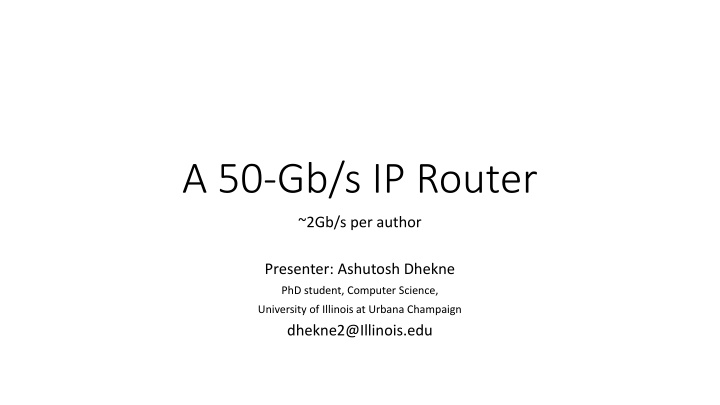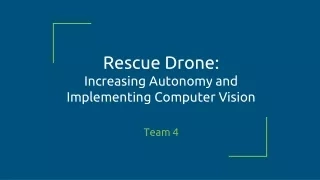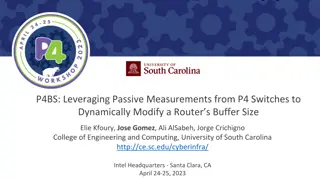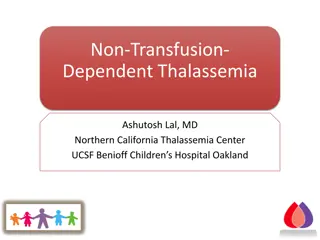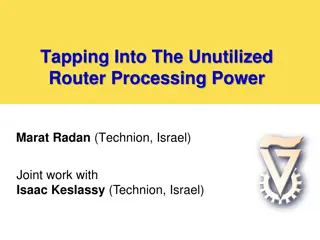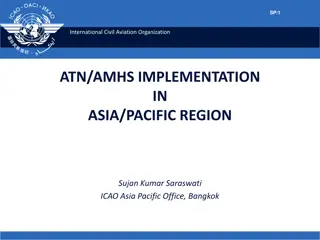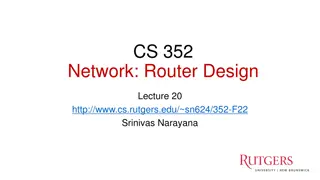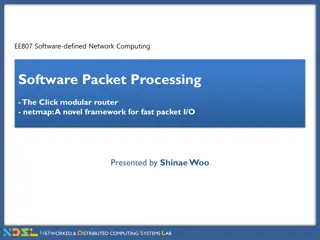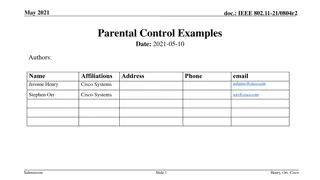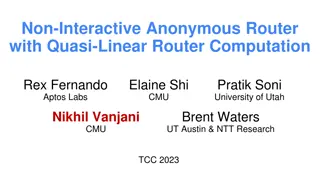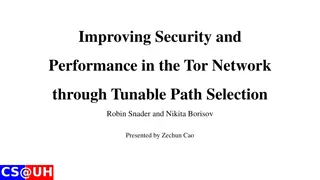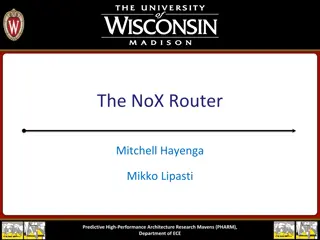A 50-Gb/s IP Router: Ashutosh Dhekne
"Presenter Ashutosh Dhekne, a PhD student in Computer Science at the University of Illinois at Urbana-Champaign, discusses a 50-Gb/s IP router with a throughput capacity of 2Gb/s per author. Contact: dhekne2@Illinois.edu."
Download Presentation

Please find below an Image/Link to download the presentation.
The content on the website is provided AS IS for your information and personal use only. It may not be sold, licensed, or shared on other websites without obtaining consent from the author.If you encounter any issues during the download, it is possible that the publisher has removed the file from their server.
You are allowed to download the files provided on this website for personal or commercial use, subject to the condition that they are used lawfully. All files are the property of their respective owners.
The content on the website is provided AS IS for your information and personal use only. It may not be sold, licensed, or shared on other websites without obtaining consent from the author.
E N D
Presentation Transcript
A 50-Gb/s IP Router ~2Gb/s per author Presenter: Ashutosh Dhekne PhD student, Computer Science, University of Illinois at Urbana Champaign dhekne2@Illinois.edu
Why so many authors? Router developing is hard Lot of hardware and assembly level software expertise Complete understanding of architectural techniques Helps shorten the acknowledgement section Okay, let's get a bit more serious!
Growth of the Internet In 2014 Paper claims that number of Internet users are doubling every year. The paper is from 1997 so over-estimates the growth a bit. Need for 50Gbps router, however, was real. Number of users and bandwidth requirement did not double every year. Cisco 7609 has 256 Gbps bandwidth Alcatel Lucent and BT tested 1.4Tbps link speed on 21 Jan 2014 Cisco 7609 Alcatel-Lucent BT
Average Packet Size In 2014 The paper uses 1000bits as average packet size What to optimize? Number of packets processed or number of bytes processed? Avg 500-700 Sharp rise at 1500
Router Components A simplistic view Output Ports Input Ports * Routing Fabric Routing Processor
Router Components Innovations Output Ports Input Ports * Forwarding Engine Routing Fabric Network Processor
Innovations Forwarding Tables Complete set of routing tables at the forwarding engine Input Ports * Forwarding Engine Reduces probability of cache miss to a great degree Routing Fabric Next Hop info only Network Processor
Innovations Switched Backplane Switched backplane instead of shared bus Input Ports * Improves speed Forwarding Engine Routing Fabric Network Processor
Innovations separate board forward engine Forwarding engines on distinct boards Input Ports * Allows flexibility Forwarding Engine Routing Fabric Allows various link layer protocols on the link card Network Processor
Innovations QoS QoS function is added Input Ports Forwarding engine classifies by assigning it to a flow * Forwarding Engine QoS Processor Routing Fabric QoS processor on the outbound card scedules the packet Network Processor
The Forwarding Engines Hardware Overview Alpha 21164 Processor 415MHz, 64 bit, 32 regs 2 int, 2 float exec units 4 instruction groups 3 internal, 1 ext cache Very high data speeds Large instruction cache Large secondary cache Control over r/w sequencing Interesting tweaks Place two pairs of int instructions together Or, place 1 pair of int and 1 pair of float instruction Fit entire fwd code in 8kB Icache Fit 12000 routes in Scache [95%] Fit all routes in Bcache Allow the network processor to update this cache
Forwarding Engine Hardware Operation In Packet ID Out Packet ID Request FIFO Alpha 21164 Processor Reply FIFO Link Layer Len Link Layer ID Src Port Src Card Type Cast Error unused IP Header (16B) Link Layer Len Error ? Multicast count Dest Tag Type Cast unused
Forwarding Engine Software Stage 1: Sanity Check Stage 2: Extended Route Stage 2: TTL, CRC Confirm that packet header is from IPv4 datagram Confirm packet length and header length is reasonable Confirm no IP options are used Compute hash offset into route cache and load route Start loading the next header
Forwarding Engine Software Stage 1: Sanity Check Stage 2: Extended Route Check Stage 2: TTL, CRC Does cached route match the destination? If not, consult the Bcache Is packet destined for this router? Then don t update TTL Update TTL otherwise
Forwarding Engine Software Stage 1: Sanity Check Stage 2: Extended Route Stage 2: TTL, CRC Updated TTL is written to IP header New checksum is written Routing info is extracted New link layer info computed Entire packet is written out
Instructions in Fast Path Some hardware specific tweaks are employed Instructions Count % Exec Unit And, bic, bis, ornot, xor 24 28 E0/E1 ext*, ins*, sll, srl, zap 23 27 E0 add*, sub*, s*add 8 9 E0/E1 nop and fnop used to pad instructions eq to efficiency gains in x86 branches 8 9 E1 ld* 6 7 E0/E1 addt, cmpt*, fcmov* 6 7 FA st* 4 5 E0 fnop 4 5 FM Many bit operations required to extract data wmb 1 1 E0 nop 1 1 E0/E1
Tricks and Exceptions IP header checksum is not checked Saves 9 cycles about 21% Errors are rare. They are corrected by TCP anyways IPv6 does not implement error checking What do modern routers do? What is not handled by fast code? Destinations that miss the route cache Headers with errors Headers with IP options Datagrams that require fragmentation Multicast datagrams
Switched Bus 15 port crossbar type switch is used Connects one source port to one destination port Multicast requires lowering of throughput and possible inherent fairness issues at any moment During a transfer 15 simultaneous transfers can happen Remember, only one output packet per port
Head of line Blocking Head of line blocking occurs when the first packet in a queue is blocked because its destination interface is busy This causes all subsequent packets to be blocked even if their dest interfaces are free Avoided in a scheme where an interface gets to disclose all interfaces it is interested in From 3 To 5 To 4 To 1 1 x From 4 To 3 To 2 To 1 2 3 4 5
Matrix of Interests Disclose all interfaces for which your queue has at least one packet Allows transfer of a packet even from behind the queue From 3 To 5 To 4 To 1 1 x 1 2 3 4 5 1 x x From 4 To 3 To 2 To 1 2 2 x 3 3 x 4 4 x 5 5 x
Wavefront Method By allowing a particular transfer to go through, the algorithm disallows few other possible transfers Therefore, instead of rasterizing through all entries look at only the allowed entries. This speeds up the algo by reducing the number of comparisons 3 is allowed to send to 1. No need to check 4 1 and 5 1 x 1 2 3 4 5 1 x x 2 x 3 x 4 x 5 x
Scheduling of switch 16 cycles Epoch 1 Source card has data for the destination card 16 cycles Epoch 2 Switch allocator decides to schedule transfer for forth epoch 16 cycles Cards are informed about the imminent transfer; data path cards are informed to configure themselves Epoch 3 16 cycles Epoch 4 Data transfer takes place
Line Card Design, Inbound, Outbound Packets OC-48c 2.4Gbps ORCA 2C04A FPGA (QoS Processor) Output Line Card Ethernet 100Mbps Input Line Card OC-12c 622Mbps Alpha 21164 Processor Forwarding Engine HIPPI 800Mbps Alpha 21064 Processor Network Processor 64 bytes pages
Conclusions Provides a huge impetus to the router industry to start working towards faster core routers. It shows that it is possible to examine every packet header and make decisions fast enough for multi Gbps routers It is unique in discussing the actual assembly level tricks to achieve the required throughput The paper creates an appreciation of the issues faced by the core routers on the Internet Routers can keep up! Right selection of hardware, placement and software is crucial.
Open Questions The network processor ARPs all possible addresses at a low frequency. Is doing such a thing acceptable on the Internet backbone? When the Network Processor writes the newly discovered routes to the B-cache, how does it synchronize with possible reads from the forwarding engine? How often do the S-cache flush because of a change in B-cache? How expensive was it to build this router? No security aspects such as mitigation of DoS attacks not discussed No audit trails
Open Questions The network processor ARPs all possible addresses at a low frequency. Is doing such a thing acceptable on the Internet backbone? When the Network Processor writes the newly discovered routes to the B-cache, how does it synchronize with possible reads from the forwarding engine? How often do the S-cache flush because of a change in B-cache? How expensive was it to build this router? No security aspects such as mitigation of DoS attacks not discussed No audit trails
Todays State of the Art Routing using GPU [link to paper] Cisco nPower X1, with 336 multi-threaded processor cores [link] The Alcatel-Lucent 7950 Extensible Routing System has 16Tbps bandwidth [link] Cisco s Carrier Routing System routes at 400Gbps per link [link]
Asia-Pacific 6007Gbps US-Canada 12100Gbps Europe 27718Gbps Africa 397Gbps Latin-America 3567Gbps [reference]
